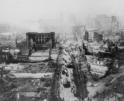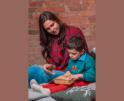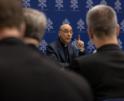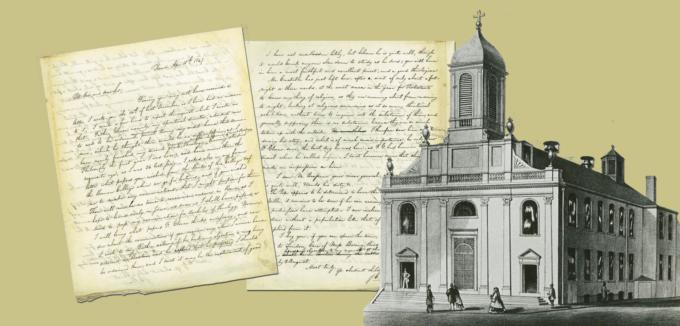
Culture
Shaw returned to Boston and entered Harvard Law School, where it is said he converted several students to Catholicism while harboring his own growing conviction that the law was not intended to be his life's work.
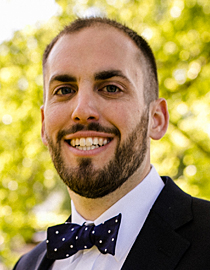
Lester
Within the archive are stories of early converts who, abandoning their Protestant New England roots, joined the Catholic faith and entered the ranks of the clergy. Noteworthy among these was Joseph Coolidge Shaw, born in Boston on Jan. 22, 1821, to Robert G. Shaw, an esteemed and wealthy Boston merchant, and his wife Elizabeth (nee Parkman). Raised a Unitarian, he entered Harvard College in 1836 and studied languages, becoming proficient in French, German, and Italian before graduating in the class of 1840.
Following graduation, Shaw spent time furthering his education in Europe and, on a trip to Rome, met Frederick William Faber who, though at the time an Anglican minister, was part of the Oxford movement which sought to renew the Church of England through a revival of Catholic doctrine and practice. Faber urged Shaw to meet with Father Thomas Glover, a Jesuit residing in Rome, which he did, and very soon after converted to the Catholic faith in 1843.
Shaw returned to Boston and entered Harvard Law School, where it is said he converted several students to Catholicism while harboring his own growing conviction that the law was not intended to be his life's work. With the blessing of his family, he returned to Rome to study for the priesthood, where he was the first Boston priest to attend the College of the Propaganda Fide.
After three years of study, 175 years ago this month, he wrote to Bishop John B. Fitzpatrick of Boston on April 15, 1847, informing him that his education was nearly complete, and he would soon depart Rome with the hope that, upon returning to Boston, he would be ordained a priest.
In the letter, it is revealed that Father Glover, with whom he met shortly before converting, continued to be Shaw's spiritual adviser and believed he was ready to be ordained. Shaw writes that Father Glover did not believe there was anything preventing his ordination, having "nearly finished my second year's Dogmatic Theology, and the whole course of Moral Theology, and have more than the requisite age as I was 26 last Jan'y." He also offered to obtain a letter from the rector of the college and prepare for any examination the bishop wished to give him.
Shaw mentions that he planned to depart Rome in early June, after taking his examination to obtain a bachelor's degree in theology, and that any reply to his letter should be sent to London, where he would collect it on his journey home.
He returned to Boston by early July, and, on Sept. 18, 1847, Joseph Coolidge Shaw was ordained a Catholic priest by Bishop Fitzpatrick at the Cathedral of the Holy Cross and celebrated his first Mass there the following day. The Pilot reported that "although it was his first appearance in the pulpit, the Rev. Gentleman acquitted himself in a manner that would do credit to older and more experienced heads. His topic was 'FAITH,' and ably did he handle it. His discourse had a powerful effect -- more especially upon our Protestant fellow citizens -- a number of whom we noticed in the church."
Father Shaw desired to return to Rome and continue his studies, but instability due to Italian unification prevented it, and he instead was sent to study at St. John's College in New York before deciding to enter the Novitiate of the Jesuits in Frederick, Maryland, in 1850.
Sadly, he quickly contracted a severe case of tuberculosis which proved fatal, and died March 10, 1851, at 30 years of age. Prior to his death, he was able to take his vows, joining the Society of Jesus on March 4. He also wrote a will, which included leaving a significant portion of his life insurance for a college or school to be established in Boston by the Jesuits, and his nearly 2,000-volume library to the same, or any other Jesuit college, school, or seminary as deemed appropriate.
The school, which was not yet established, would be Boston College, which opened in the South End of the city on Sept. 5, 1864. About 350 volumes from Father Shaw's library did make their way to the college, forming a significant portion of the original library, and are now in the Boston College Burns Library. Furthermore, the Shaw House on the Chestnut Hill campus, dedicated in 1962, houses 20 freshmen who take part in the Shaw Leadership Program, both named after this promising young priest.
Note: Twenty-two years after Father Shaw's death, his nephew, Colonel Robert Gould Shaw, named for Joseph Coolidge's father, would be immortalized with a statue on the Boston Common after being killed in action at Fort Wagner, South Carolina, leading the 54th Massachusetts Infantry Regiment in the American Civil War.
- Thomas Lester is the archivist of the Archdiocese of Boston.
Recent articles in the Culture & Events section
-
Boston and the nation respond to the San Francisco Earthquake of 1906Thomas Lester
-
See you in the storyLaura Kelly Fanucci
-
'Dignitas' and the mediaRussell Shaw
-
Scripture Reflection for April 14, 2024, Third Sunday of EasterDeacon Greg Kandra
-
St. Helena's House is established in the South EndThomas Lester

